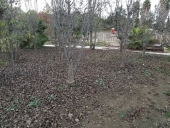We have a pile of wood and a clean stovepipe.
Planted a few dozen trees and shrubs over late fall/early winter (mostly native "wildlife mix" bareroot type stuff along with 10 highbush bl. berry and 10 everbearing rasp., some clumping+dwarf bamboo, 2 dozen pawpaw seedlings etc.) and currently waiting it out until the second round of bareroots arrive in the spring.
We are looking forward to planting 6 American chestnut (seedlings from a stand of blight-immune/resistant trees), hardy pecans, butternuts, more currants, etc.
Current noteworthy building project has been transitioning our 8 chickens from a static coop to a mobile tractor system. Have slapped together 1 of 2 necessary tractors; making these light and on the cheap so it's basically a scrap pine frame wired in on the sides with a tarp for a roof and a built-in hardwood pole perch.










